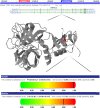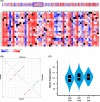Molecular mechanisms involved in anosmia induced by SARS-CoV-2, with a focus on the transmembrane serine protease TMPRSS2
- PMID: 35939103
- PMCID: PMC9358639
- DOI: 10.1007/s00705-022-05545-0
Molecular mechanisms involved in anosmia induced by SARS-CoV-2, with a focus on the transmembrane serine protease TMPRSS2
Abstract
Since 2020, SARS-CoV-2 has caused a pandemic virus that has posed many challenges worldwide. Infection with this virus can result in a number of symptoms, one of which is anosmia. Olfactory dysfunction can be a temporary or long-term viral complication caused by a disorder of the olfactory neuroepithelium. Processes such as inflammation, apoptosis, and neuronal damage are involved in the development of SARS-CoV-2-induced anosmia. One of the receptors that play a key role in the entry of SARS-CoV-2 into the host cell is the transmembrane serine protease TMPRSS2, which facilitates this process by cleaving the viral S protein. The gene encoding TMPRSS2 is located on chromosome 21. It contains 15 exons and has many genetic variations, some of which increase the risk of disease. Delta strains have been shown to be more dependent on TMPRSS2 for cell entry than Omicron strains. Blockade of this receptor by serine protease inhibitors such as camostat and nafamostat can be helpful for treating SARS-CoV-2 symptoms, including anosmia. Proper understanding of the different functional aspects of this serine protease can help to overcome the therapeutic challenges of SARS-CoV-2 symptoms, including anosmia. In this review, we describe the cellular and molecular events involved in anosmia induced by SARS-CoV-2 with a focus on the function of the TMPRSS2 receptor.
© 2022. The Author(s), under exclusive licence to Springer-Verlag GmbH Austria, part of Springer Nature.
Conflict of interest statement
None of the authors declare a conflict of interest.
Figures



Similar articles
-
Structural Basis of Covalent Inhibitory Mechanism of TMPRSS2-Related Serine Proteases by Camostat.J Virol. 2021 Sep 9;95(19):e0086121. doi: 10.1128/JVI.00861-21. Epub 2021 Jun 23. J Virol. 2021. PMID: 34160253 Free PMC article.
-
The TMPRSS2 Inhibitor Nafamostat Reduces SARS-CoV-2 Pulmonary Infection in Mouse Models of COVID-19.mBio. 2021 Aug 31;12(4):e0097021. doi: 10.1128/mBio.00970-21. Epub 2021 Aug 3. mBio. 2021. PMID: 34340553 Free PMC article.
-
Camostat mesylate inhibits SARS-CoV-2 activation by TMPRSS2-related proteases and its metabolite GBPA exerts antiviral activity.EBioMedicine. 2021 Mar;65:103255. doi: 10.1016/j.ebiom.2021.103255. Epub 2021 Mar 4. EBioMedicine. 2021. PMID: 33676899 Free PMC article.
-
Spiking dependence of SARS-CoV-2 pathogenicity on TMPRSS2.J Med Virol. 2021 Jul;93(7):4205-4218. doi: 10.1002/jmv.26911. Epub 2021 Mar 18. J Med Virol. 2021. PMID: 33638460 Free PMC article. Review.
-
Targeting the intestinal TMPRSS2 protease to prevent SARS-CoV-2 entry into enterocytes-prospects and challenges.Mol Biol Rep. 2021 May;48(5):4667-4675. doi: 10.1007/s11033-021-06390-1. Epub 2021 May 22. Mol Biol Rep. 2021. PMID: 34023987 Free PMC article. Review.
Cited by
-
The immune mechanism of the nasal epithelium in COVID-19-related olfactory dysfunction.Front Immunol. 2023 Jul 17;14:1045009. doi: 10.3389/fimmu.2023.1045009. eCollection 2023. Front Immunol. 2023. PMID: 37529051 Free PMC article. Review.
-
Exploring the research landscape of COVID-19-induced olfactory dysfunction: A bibliometric study.Front Neurosci. 2023 Mar 24;17:1164901. doi: 10.3389/fnins.2023.1164901. eCollection 2023. Front Neurosci. 2023. PMID: 37034158 Free PMC article. Review.
-
Transcriptome from Paired Samples Improves the Power of Comprehensive COVID-19 Host-Viral Characterization.Int J Mol Sci. 2023 Aug 23;24(17):13125. doi: 10.3390/ijms241713125. Int J Mol Sci. 2023. PMID: 37685932 Free PMC article.
-
Viral Etiologies and Histopathological Features of Olfactory Dysfunction: A Systematic Review.Health Sci Rep. 2025 Jun 18;8(6):e70917. doi: 10.1002/hsr2.70917. eCollection 2025 Jun. Health Sci Rep. 2025. PMID: 40535522 Free PMC article. Review.
-
Prevalence of Olfactory Dysfunction with the Omicron Variant of SARS-CoV-2: A Systematic Review and Meta-analysis.medRxiv [Preprint]. 2023 Jan 19:2022.12.16.22283582. doi: 10.1101/2022.12.16.22283582. medRxiv. 2023. Update in: Cells. 2023 Jan 28;12(3):430. doi: 10.3390/cells12030430. PMID: 36561176 Free PMC article. Updated. Preprint.
References
Publication types
MeSH terms
Substances
LinkOut - more resources
Full Text Sources
Medical
Miscellaneous

